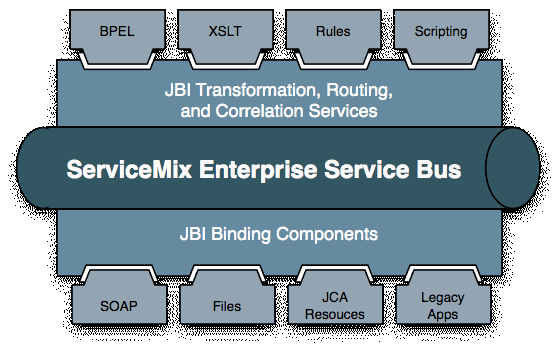Apache ServiceMix is a runtime container for service-oriented architecture components, web services or legacy system connectivity services. It is one of the most mature, open-source implementations of an enterprise service bus and an Apache top-level project. In this article we will take a look at what ServiceMix is and how it can be put to use.Web Site: http://servicemix.apache.orgVersion discussed: Apache ServiceMix 3.3, FUSE ESB 3.4 License & Pricing: Open Source with commercial support and packaging by FuseSourceSupport: User mailing list, developer mailing list, Internet Relay Chat, FuseSource forums. Only the book "Open-Source ESBs in Action" by Manning is currently available. IntroductionBefore directly starting to discuss what Apache ServiceMix can be used for, a general understanding of the enterprise service bus acronym should be given. Since it is not a framework suited for everyday usage like Spring, the general context of its application is important. Enterprise Service Bus (ESB) principleApache ServiceMix is an implementation of an enterprise service bus in the Java programming language.In a typical enterprise environment, there are several applications installed. Most probably they are from different vendors and offer very diverse interfaces. The corporate IT commonly faces two challenges these days: Exchange of data between different systems
Creation of new functionality by combining existing function block from these applications
In the past, these issues were tackled by proprietary product suites, which often were highly specialized and not able to cover a wide range of corporations' needs. The development and adoption of web service technology is thought to solve these issues, as a common transport and description format now exists. Nonetheless, this needs to be provided, implemented and supported by the applications. Also, a single call often is not sufficient, but routing and combination logic needs to be employed, as well. To simplify these tasks, Gartner came up with the idea of an infrastructure component, which uses a harmonized way of exchanging data (messages) and provided such reusable core functionality. This component should not only exchange messages but also incorporate the ability to route messages from one component to another component. These requirements were bundled into the term "enterprise service bus" (ESB). In contrast to enterprise application integration (EAI), the ESB concept goes beyond the mere connectivity and data exchange principles and focuses on reuse. By exposing application functionality to an ESB, new applications can be built that leverage data and services already created. These are then called "composite applications", as they can be thought off as a meta-level, creating applications from applications, instead of components or frameworks. This functionality can also be leveraged without using an enterprise service bus, but for the typical everyday challenges, a bus greatly simplifies things, since it is prepackaged with components and standard functionality. Java Business Integration (JBI)To standardize the ESB concept, the Java Community Process (JCP) came up with the JBI standard, short for Java Business Integration. It describes all components, which can be found in the ESB concept, matched to Java terminology and interfaces.
Read more: Methods & Tool
Creation of new functionality by combining existing function block from these applications
In the past, these issues were tackled by proprietary product suites, which often were highly specialized and not able to cover a wide range of corporations' needs. The development and adoption of web service technology is thought to solve these issues, as a common transport and description format now exists. Nonetheless, this needs to be provided, implemented and supported by the applications. Also, a single call often is not sufficient, but routing and combination logic needs to be employed, as well. To simplify these tasks, Gartner came up with the idea of an infrastructure component, which uses a harmonized way of exchanging data (messages) and provided such reusable core functionality. This component should not only exchange messages but also incorporate the ability to route messages from one component to another component. These requirements were bundled into the term "enterprise service bus" (ESB). In contrast to enterprise application integration (EAI), the ESB concept goes beyond the mere connectivity and data exchange principles and focuses on reuse. By exposing application functionality to an ESB, new applications can be built that leverage data and services already created. These are then called "composite applications", as they can be thought off as a meta-level, creating applications from applications, instead of components or frameworks. This functionality can also be leveraged without using an enterprise service bus, but for the typical everyday challenges, a bus greatly simplifies things, since it is prepackaged with components and standard functionality. Java Business Integration (JBI)To standardize the ESB concept, the Java Community Process (JCP) came up with the JBI standard, short for Java Business Integration. It describes all components, which can be found in the ESB concept, matched to Java terminology and interfaces.

Read more: Methods & Tool



0 comments:
Post a Comment